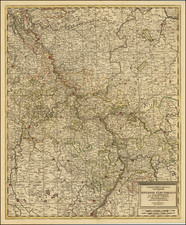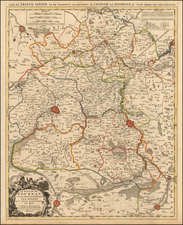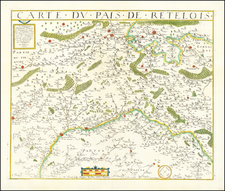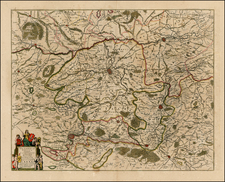Changes to a River Lock System to Allow for Upgrades to Ironworks during the French Industrial Revolution
Massive, magnificent manuscript plan of a stretch of the Romaine River, in the Haute-Saone Department, surveyed for the benefit of the masters of the local ironworks who were seeking to upgrade their furnaces to the most modern technologies. This would require changes to the locks on the river, which are illustrated in three pastedowns on the map.
The map centers on the town of Mazieres, in the department of Haute Saone in eastern France, located 45 miles east of Dijon. Shown is a two-mile stretch of river with an incredible amount of detail, naming landowners and buildings adjacent to the river. Along the top of the map is a transect of the river showing how its elevation drops over the region shown. Detail is most focused on buildings that interfere with the river, including the forge and local millworks. A key lists twenty points of interest, providing even greater detail on the flow of the river.
The survey was executed for the local ironworks, which were seeking to add numerous features to the extant buildings. In particular, they were looking to add a reverberatory furnace, which separates the fuel from the product, among other additions. These would In order to make these work, it is apparent that changes needed to be made to the lock system. It is for this purpose that the pastedowns are included, they evidently show updates to lock technology. By changing the workings of the locks, the flow conditions at the forge would change, and increased flow would allow for more efficient operation.
These forges were owned by Pierre-Francois Galaire and his brother-in-law Jean-Baptiste Patret, who owned a number of forges and foundries in the region. This plan was reviewed by a surveyor of Haute Saone, M. Maruand, who signed off on this production at his residence in Port-sur-Saone.
Water-Driven Ironworks in Eastern France
In 1821, the industrial revolution was in full force in France. Iron processing was one of the major economies which grew rapidly during the entirety of the revolution, from its start in the late 17th-century until the late 19th-century. The reverberatory furnace allowed for cast iron to be produced using mined coal due to its separation of fuel and product which prevents the transmission of impurities. In addition, in England, the steam engine allowed for the operation of bellows which overcame insufficiencies in the amount of iron power. However, on the continent, forges were able to benefit from increased water power.
Several important forges in Haute Saone were owned by the Gailaire and Patret pair at the time when this map was surveyed. Notably, the forges at Varigney, now a historic monument, had operated since the late 17th century and were responsible for processing 300,000 pounds of raw iron ore at the time. Expansions to these ironworks were happening constantly and would have required constant resurveying and new technologies, such as those shown here.
The iron produced here would have fed a positive-feedback loop in which this iron would have fed industrial innovation, which would require more iron production, and therefore upgrades to ironworks. Water engineering works such as those shown here would have been instrumental to feeding the industrial revolution as we know it.












![[Paris Environs - Southeast] Carte Routiere pour Automobilistes & Cyclistes -- Environs de Paris Section Sud-Est](https://storage.googleapis.com/raremaps/img/small/95862.jpg)
![[Champagne Region] Gouvernement General De Champagne ou sont divisees Les Esclections, De La Generalite De Chaalons … De Paris et De Soissons . . .](https://storage.googleapis.com/raremaps/img/small/74520.jpg)
